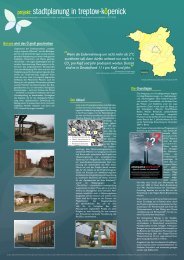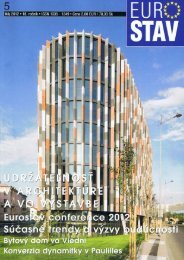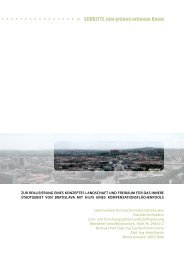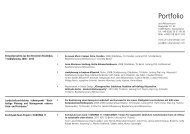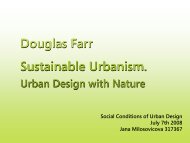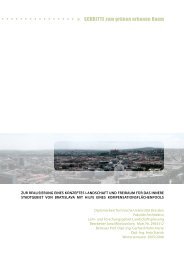This implies that there is an acute need to understand:• ‘Solar radiation’ – as a desired energy flow; the priority in summer months howeverbeing to prevent overradiation and out of it resulting overheating. This implies thatthe urban form shall be compact and the spaces shaded. However, since built structuresand anthropogenic heat release contribute significantly to the city’s atmospherewarming, the compactness must conform to the ability of the given urbanenvironment to tackle the heat loads by providing sufficient evaporative cooling andnatural ventilation.• ‘Water’ – as rainfall that is to be kept on ground in water bodies and plants andevapotranspired into the adjacent atmosphere, while having significant coolingeffect;• ‘Vegetation’ not only as a component in parks – more than that, all natural as wellas man-made surfaces should possibly be vegetated;• ‘Ventilation’ – the air permeability must be provided at each city’s, district’s, urbanblock’s and building’s level. Here, the orientation of the streets, the urban form –density/compactness and geometry play a distinctive role.“Re-greening cities withan aggressive policy: notleftovers but priority.”(Katzschner and Katzschner2008)Based on this knowledge, the <strong>Thesis</strong> produced a comprehensive set of Climate-Sensitive<strong>Urban</strong> <strong>Design</strong> Guidelines. Briefly summarized, “Climate-Sensitive <strong>Urban</strong> <strong>Design</strong>” meansthat shading of open space in summer months is provided with the help of vegetation,built elements and appropriate urban geometry; permeable, high albedosurfaces are used where soil sealing is unavoidable; water, particularly rainwater, isconsidered being valuable element and as such is widely used in open space to providedesired cooling effect; vegetation is planted wherever possible, in open spacesas well as on the roofs and façades of buildings; ventilation channels are providedto allow the flow of cooler air from the surrounding countryside into the city centre, orbetween climatic compensation areas and impact areas; and finally yet importantly, eachurban district and urban block features sufficient natural ventilation provisions.These features were then applied and visualized in the design for a Case Study urbanproject, the Berlin’s Heidestrasse/Europacity, showing that it is possible to achieve moderate-to high density urban areas that, with particular design provisions, can effectivelyinfluence and alleviate the UHI at the local, district level.Unlike in other sources, the focus of this <strong>Thesis</strong> was not on buildings’ energy efficiencyand on motorized traffic reduction, but on buildings’ masses, urban form, and the thermaland climatic effects of urban areas as such.As the <strong>Thesis</strong> shows, many factors have to be considered before deciding on the appropriate,climate-sensitive urban form and design. Yet, besides the general aspectsdiscussed in the <strong>Thesis</strong>, the specific type of measures will depend on the particular geographicallocation and local conditions, such as terrain inclination, precipitation, etc.“Prescribing urban form to mitigate and adapt to climate change simultaneously isextremely challenging, if not impossible. Although mitigating climate change is bestachieved by designing settlement patterns that do not contribute to more GHG releasesdue to the excessive use of energy (…), adapting to climate change involves a morecomplex set of issues (Pizarro 2009, p. 42)”. This <strong>Thesis</strong> responded to this challenge andattempted to present a complex set of best urban design practices that will help citiesadapt to extreme temperatures and to mitigate the climate change.The aim has been to address not only urban design professionals and planning communitiesbut also other stakeholders in urban development; and to present and highlightthe applicability for any country or city in the cool moderate climate zone.4 Conclusions59
Complementing recommendations regarding the CSUD policiesfor municipalitiesIt is an immense challenge to enforce implementation of the CSUDpractices and gain an acceptation by municipalities, planning communities,developers and other stakeholders involved in the city-buildingprocesses. Therefore, the tasks are to research, to widen the gainedknowledge via education of the public as well as professionals, and toenforce the implementation with the help of guidelines, policies andbylaws. Given the complexity of this subject, that is not possibly to becovered within this <strong>Thesis</strong>, only a few thoughts on these issues will bebrought:It would make sense to have evaluation criteria for climatic factors,such as threshold values for maximal heat island intensity of adevelopment; minimum amount of climate-efficient cold airflow intoa settlement; or minimum size of ventilation channels that guaranteea sufficient provision of the city with cold air (Hahn-Herse 1997, Section‘Climate’, p. 61). Additionally, all cities should develop and pursuedesign guidelines, as, for example the Chicago’s ‘Stormwater BestManagement Practices’. The most effective way to make sure, that thedevelopments will conform to the desired values however are legallybinding prescriptions.A number of cities have introduced comprehensive green infrastructure(especially green roof) policies, such as Stuttgart, Münster, Toronto,Chicago, New York, Tokyo and many others; which turned to bylaw ina few of them (e.g. Toronto’s Green Roof Bylaw 56 ). These policies donot particularly address urban design but are a valuable way to enableeasier implementation.To increase the acceptability of the required design practices, the investorsmight be attracted by monetary offsets for including theclimate-sensitive design features, such as in the case of the fee splittingin Berlin, when the costs are reduced if rainwater is not led intothe central sewerage (SenStadt – Rainwater II, online). Another wayto motivate investors is by pursuing high climate-effective ratingin rating systems, such as the Canadian LEED-ND 57 or the GermanDGNB’s 58 “Quarter-Related Environmental Standards”.Finally yet importantly: the land uptake for urbanization results in destroyingclimatic compensation areas. To tackle this problem, national-widepolices are to be considered and possibly adjusted. One ofthe aspects is the pro-head housing area that is in some countriesconsiderably higher than in others; and does not necessarily mean anenhancement in the quality of life in the cities. In Shanghai, China, thehousing area is only about 9m 2 /p.P. 59 , whereas in Germany 42m 2 /p.P.or in USA 68.1m 2 /p.P. (ifS 2006). A way would be to educate and motivatethe public and to pursue compact types of developments not onlyby the Site Ocupancy Index, but also by the pro-head housing area.56 www.toronto.ca/greenroofs/overview.htm57 Details in LEED-ND provisions on UHI see Appendix 858 German Association for Sustainable Building59 de.wikipedia.org/wiki/Shanghai. Accessed on 26.7.201060Climate Sensitive <strong>Urban</strong> <strong>Design</strong> in Moderate Climate Zone: Responding to Future Heat Waves. Case Study Berlin Heidestrasse/Europacity



